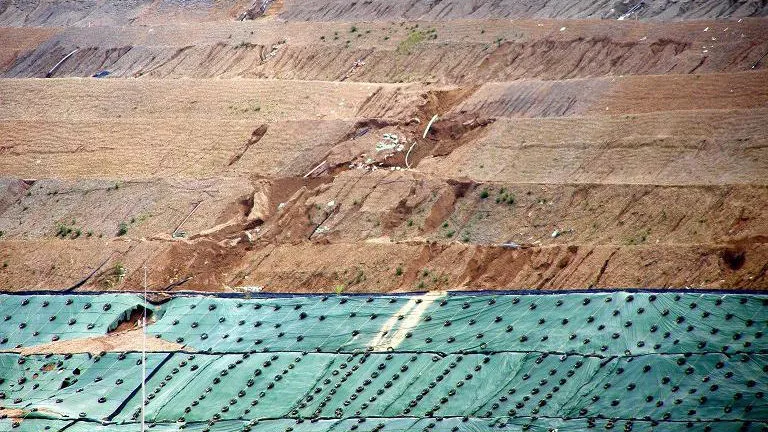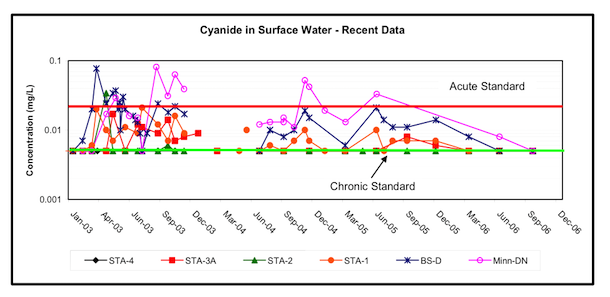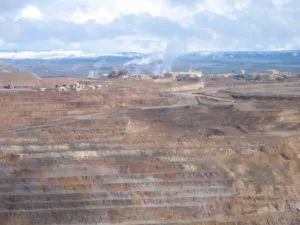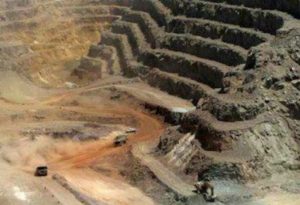What is cyanide?
Cyanide is a rapidly acting, potentially deadly chemical.
“Cyanide” can mean any one of various compounds containing the chemical group CN: one atom of carbon (C) and one atom of nitrogen (N). Because it is organic, it reacts readily with living organisms.
Cyanide easily combines with many metals—making it useful in separating metals like gold from their ore.
How is cyanide used in mining?
A sodium cyanide solution is commonly used to leach gold from ore. There are two types of leaching:
- Heap leaching: In the open, cyanide solution is sprayed over huge heaps of crushed ore spread atop giant collection pads. The cyanide dissolves the gold from the ore into the solution as it trickles through the heap. The pad collects the now metal-impregnated solution which is stripped of gold and resprayed on the heap until the ore is depleted.
- Vat (or tank) leaching: The ore is mixed with cyanide solution in large tanks. Although the chances of spills are lower because the leaching process is more controlled, the resulting waste, known as tailings, is stored behind large dams (tailings impoundments) which can and do fail catastrophically.

Cyanide’s efficiency makes mining more wasteful
Because cyanide leaching is very efficient, it allows profitable mining of much lower ore grades.
Mining lower grade ore requires the extraction and processing of much more ore to get the same amount of gold. Partially due to cyanide, modern mines are
- much larger than before cyanide was used;
- create vast open pits; and
- produce huge quantities of waste.
More than 20 tons of mine waste are generated to produce enough gold for a typical ring.

What are the dangers of using cyanide?
Cyanide is highly toxic, and can result in substantial environmental impacts and public health risks if released into the environment. Cyanide spills have resulted in major fish kills, contaminated drinking water supplies and harmed agricultural lands. For example:
- Mexico, 2014: 500,000 gallons of cyanide solution spilled from a retaining pond at the Proyecto Magistral mine, after heavy rains.
- Kyrgyzstan, Kumtor Gold Mine, 1998: A truck carrying 2 tons of sodium cyanide crashed into the Barskoon river, resulting in more than 2,000 people seeking medical care.
- Romania, Aural Gold, 2000: A tailings dam ruptured, spilling 3.5 million cubic feet of cyanide-contaminated waste into the Tisza and Danube Rivers, killing fish and poisoning water supplies as far as 250 miles downriver in Hungary and Yugoslavia.
- United States, Zortman-Landusky Mine, Montana, 1982: 52,000 gallons of cyanide solution poisoned the aquifer that supplies fresh drinking water for the town of Zortman. The accident was discovered when an employee of the mine noticed the smell of cyanide in his tap water at home.
Cyanide spills can persist in the environment
Industry claims cyanide is relatively safe because—even if it spills—it breaks down rapidly in surface water.
But the compounds that cyanide breaks down into can be harmful.
Cyanide spills into groundwater can persist for long periods of time and contaminate drinking water aquifers. Cyanide contaminated groundwater can also pollute hydrologically connected neighboring streams.
For example, at the Beal Mountain Mine in Montana which closed in 1998, cyanide seeped into groundwater that feeds neighboring trout streams, resulting in cyanide violations in those streams long-after the mine closed.

The bottom line
Today’s hardrock mining industry too often spills cyanide, billions of gallons of contamination released into the environment since the 1970s. Spills and leaks—which continue to this day—endanger the environment, wildlife and humans.
For More Information
- Earthworks Cyanide Leach Packet
- Earthworks Cyanide Fact Sheet
- Earthworks Cyanide Uncertainties
- Earthworks More Cyanide Uncertainties
- UNEP The Cyanide Spill at Baia Mare, Romania: Before, During and After
- USGS Cyanide toxicity in birds







